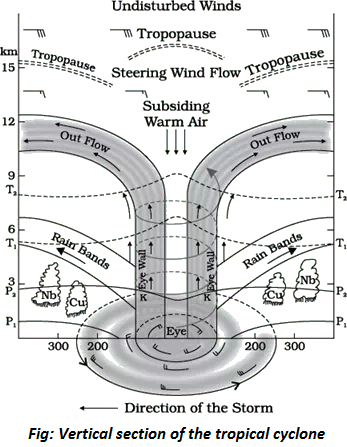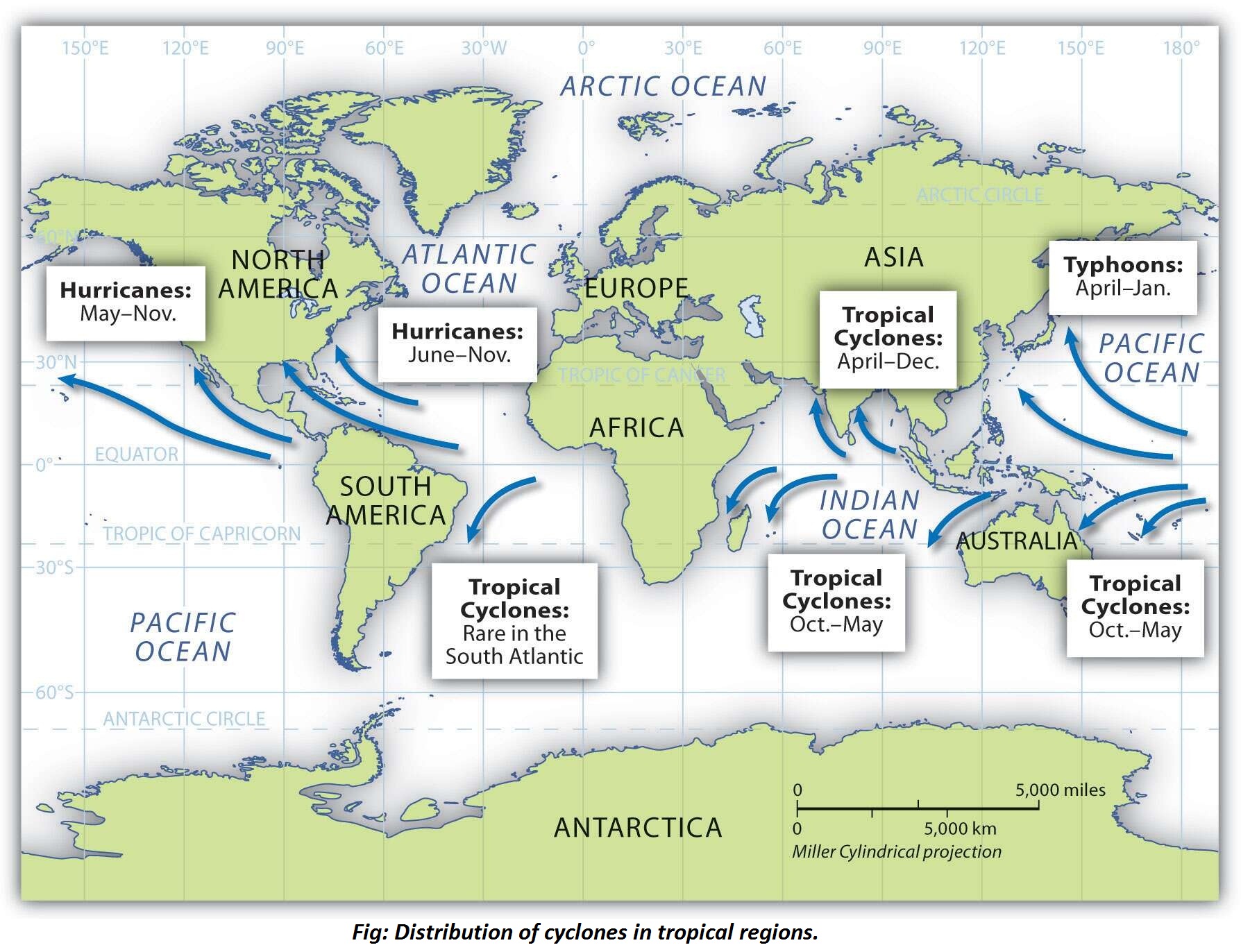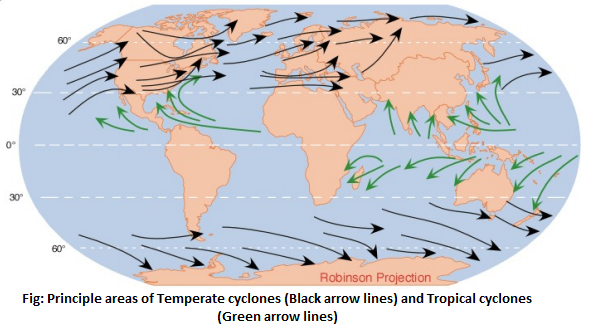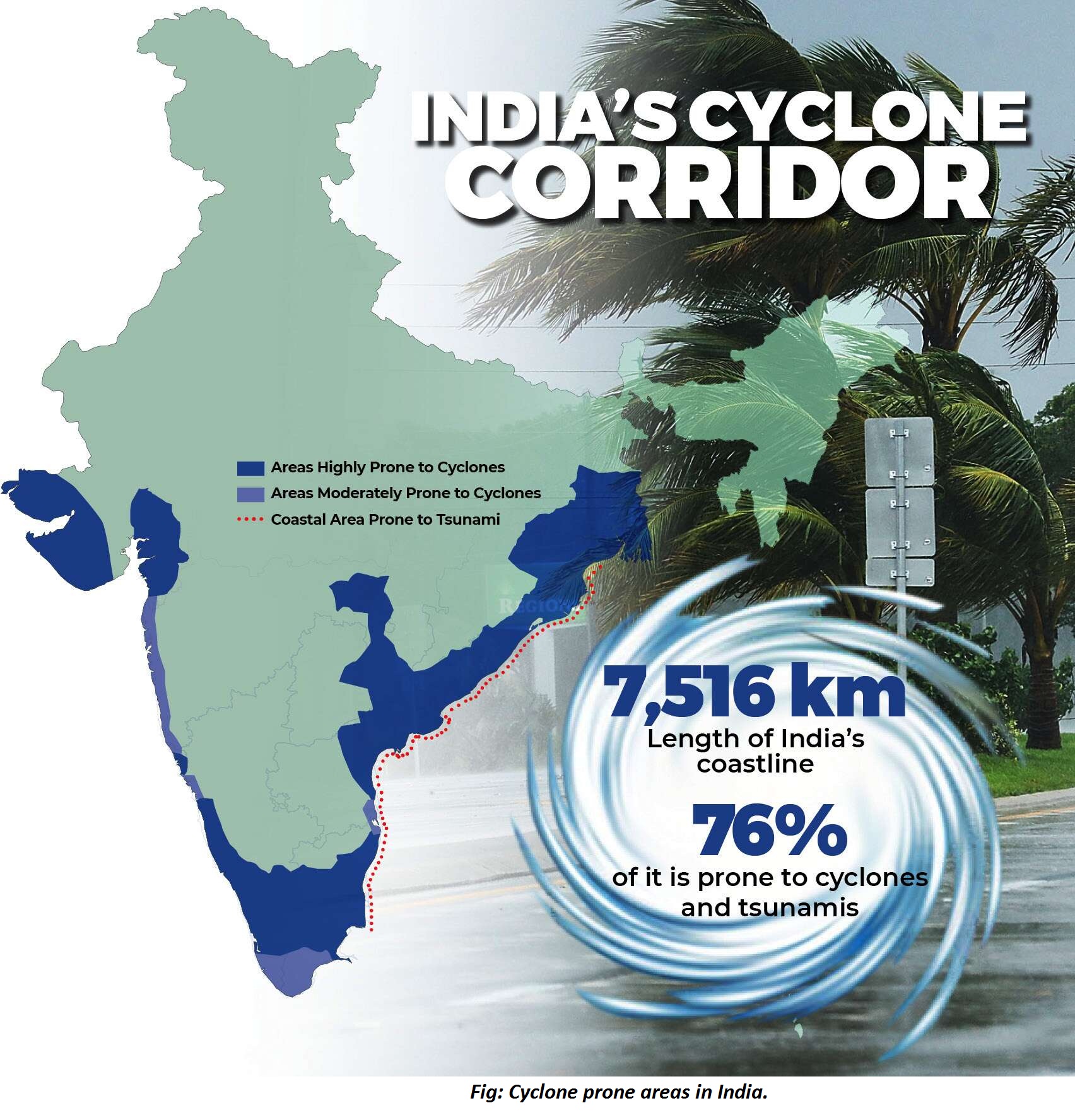Geography
Cyclone
- 04 Jun 2020
- 14 min read
Why in news
In the year 2020, Cyclone Amphan (pronounced as UM-PUN) formed over Bay of Bengal intensified and turned into a “super cyclonic storm” , the second super cyclone since 1999. In another incident Mumbai has been hit by a cyclone (Cyclone Nisarga) after a gap of 129 years.
Introduction
- Cyclones are rapid inward air circulation around a low-pressure area. The air circulates in an anticlockwise direction in the Northern hemisphere and clockwise in the Southern hemisphere.
- Cyclones are usually accompanied by violent storms and bad weather.
- The word Cyclone is derived from the Greek word Cyclos meaning the coils of a snake. It was coined by Henry Peddington because the tropical storms in the Bay of Bengal and the Arabian Sea appear like coiled serpents of the sea.
Classification
- There are two types of cyclones:
- Tropical cyclones; and
- Extra Tropical cyclones (also called Temperate cyclones or middle latitude cyclones or Frontal cyclones or Wave Cyclones).
- The World Meteorological Organisation uses the term 'Tropical Cyclone’ to cover weather systems in which winds exceed ‘Gale Force’ (minimum of 63 km per hour).
- Tropical cyclones develop in the region between the Tropics of Capricorn and Cancer. They are large-scale weather systems developing over tropical or subtropical waters, where they get organized into surface wind circulation.
- Extra tropical cyclones occur in temperate zones and high latitude regions, though they are known to originate in the Polar Regions.
Anticyclones
- An anticyclone is the opposite of a cyclone i.e. i.e., it has an outward-spiralling air circulation around a high pressure centre.
- An anticyclone’s winds rotate clockwise in the Northern Hemisphere around a center of high pressure.
- In anticyclones, air comes in from above and sinks to the ground. High pressure centers generally have fair weather.
Tropical Cyclones
- Tropical cyclones are violent storms that originate over oceans in tropical areas and move over to the coastal areas bringing about large scale destruction caused by violent winds, very heavy rainfall and storm surges.
- Tropical Cyclones are one of the most devastating natural calamities in the world.
- Tropical cyclones originate and intensify over warm tropical oceans. The conditions favourable for the formation and intensification of tropical storms are:
- Large sea surface with temperature higher than 27° C.
- Presence of the Coriolis force.
- Small variations in the vertical wind speed.
- A pre-existing weak low- pressure area or low-level-cyclonic circulation.
- Upper divergence above the sea level system.
Stages of Formation: Tropical Cyclones
The development cycle of tropical cyclones may be divided into three stages:
Formation and Initial Development Stage
- The formation and initial development of a cyclonic storm depends upon the transfer of water vapour and heat from the warm ocean to the overlying air, primarily by evaporation from the sea surface.
- It encourages formation of massive vertical cumulus clouds due to convection with condensation of rising air above the ocean surface.
Mature Stage
- When a tropical storm intensifies, the air rises in vigorous thunderstorms and tends to spread out horizontally at the tropopause level. Once air spreads out, a positive pressure at high levels is produced, which accelerates the downward motion of air due to convection.
- With the inducement of subsidence, air warms up by compression and a warm ‘Eye’ (Low pressure centre) is generated. The main physical feature of a mature tropical cyclone in the Indian Ocean is a concentric pattern of highly turbulent giant cumulus thundercloud bands.
Modification and Decay
- A tropical cyclone begins to weaken in terms of its central low pressure, internal warmth and extremely high speeds, as soon as its source of warm moist air begins to ebb or is abruptly cut off.
- This happens after its landfall or when it passes over cold waters.
Nomenclature of Tropical Cyclones
- The naming of tropical cyclones is a recent phenomenon. The process of naming cyclones involves several countries in the region and is done under the aegis of the World Meteorological Organization (WMO).
- For the Indian Ocean region, a formula for naming cyclones was agreed upon in 2004. Eight countries in the region - Bangladesh, India, Maldives, Myanmar, Oman, Pakistan, Sri Lanka and Thailand - all contributed a set of names which are assigned sequentially whenever a cyclonic storm develops.
- Hudhud, Titli, Phethai, Fani, Vayu and Amphan are among the names of cyclones in the Indian Ocean region.
Worldwide Terminology of Tropical Cyclones
- They are given many names in different regions of the world – eg.they are known as Typhoons in the China Sea and Pacific Ocean; Hurricanes in the West Indian islands in the Caribbean Sea and Atlantic Ocean; Tornados in the Guinea lands of West Africa and southern USA.; Willy-willies in north-western Australia and Tropical Cyclones in the Indian Ocean.
Extratropical Cyclone
- Extratropical cyclones are referred to as mid-latitude depressions, temperate cyclones, frontal depressions and wave cyclones.
- These are active above the mid-latitudinal region between 35° and 65° latitude in both the hemispheres. The direction of movement is from west to east and more pronounced in the winter seasons. It is in these latitude zones the polar and tropical air masses meet and form fronts
Formation of Extratropical Cyclones
- The origin and development of temperate cyclones is best explained by the Polar Front theory.
- According to this theory, the warm-humid air masses from the tropics meet the dry-cold air masses from the poles and thus a polar front is formed.
- The cold air mass is denser and heavier and due to this reason, warm air mass is pushed up.
- This interaction of cold and warm air masses creates instability and a low pressure is created at the junction particularly in the center of interactions.
- Thus, a void is created because of lessening of pressure. The surrounding air rushed in to occupy this void and coupled with the earth’s rotation a cyclone is formed.
- Extratropical cyclones present a contrast to the more violent cyclones or hurricanes of the tropics, which form in regions of relatively uniform temperatures.
Air Mass
- Air Mass is an extremely large body of air whose properties of temperature and moisture content (humidity), at any given altitude, are fairly similar.
- It can cover hundreds of thousands of square miles of area.
- It may have only a little horizontal variation in temperature and moisture throughout the air mass.
- When an air mass remains over a homogenous area for a sufficiently longer time, it acquires the characteristics of the area. The homogenous regions can be the vast ocean surface or vast plains.
Fronts
- When two different air masses (having distinctly different properties) meet, the boundary zone between them is called a front.
- There are four types of fronts:
- Stationary front: When the front remains stationary, it is called a stationary front.
- Cold front: When the cold air moves towards the warm air mass, its contact zone is called the cold front,
- Warm front: If the warm air mass moves towards the cold air mass, the contact zone is a warm front.
- Occluded front: If an air mass is fully lifted above the land surface, it is called the occluded front.
- The fronts occur in middle latitudes and are characterised by steep gradient in temperature and pressure. They bring abrupt changes in temperature and cause the air to rise to form clouds and cause precipitation.
Cyclones in India
Tropical Cyclones
- Tropical cyclones originate over the Bay of Bengal, Arabian Sea and the Indian ocean. These tropical cyclones have very high wind velocity and heavy rainfall and hit the Indian Coastal states of Tamil Nadu, Andhra Pradesh, West Bengal,Odisha and Gujarat (These five states are more vulnerable to cyclone disasters than others in India).
- Most of these cyclones are very destructive due to high wind velocity and torrential rain that accompanies it.
- There are three elements associated with cyclones which cause destruction during its occurrence. These are-
- Strong Winds/Squall: It damages installations, dwellings, communications systems, trees etc., resulting in loss of life and property.
- Torrential rains and inland flooding: Rain is a serious problem for the people who become shelter less due to the cyclone. Heavy rainfall is usually spread over a wide area and causes large scale soil erosion and weakening of embankments.
- Storm Surge: It is an abnormal rise of sea level near the coast caused by a severe tropical cyclone. Due to storm surge sea water inundates low lying areas of coastal regions drowning human beings and livestock, causes eroding beaches and embankments, destroys vegetation and leads to reduction of soil fertility.
Management of Cyclones
There are many structural and non-structural measures for effective disaster management of cyclones.
- The structural measures include construction of cyclone shelters, construction of cyclone resistant buildings, road links, culverts, bridges, canals, drains, saline embankments, surface water tanks, communication and power transmission networks etc.
- Non-structural measures like early warning dissemination systems, management of coastal zones, awareness generation and disaster risk management and capacity building of all the stakeholders involved.
- These measures are being adopted and tackled on a State to State basis under the National Cyclone Risk Mitigation Project (NCRMP) being implemented through World Bank Assistance.
Western Disturbance
- Western Disturbance is a common weather phenomena in India. A western disturbance is an extratropical cyclone originating in the Mediterranean region that brings sudden winter rain to the northwestern parts of the Indian subcontinent.
- They are the cause of the most winter and pre-monsoon season rainfall across North-West India (such as Punjab, Haryana, Delhi and western Uttar Pradesh). This phenomenon is usually associated with cloudy sky, higher night temperatures and unusual rain.
- This precipitation during the winter season has great importance in agriculture particularly for rabi crops including wheat. It is estimated that India gets close to 5-10% of its total annual rainfall from western disturbances.
Read More:











